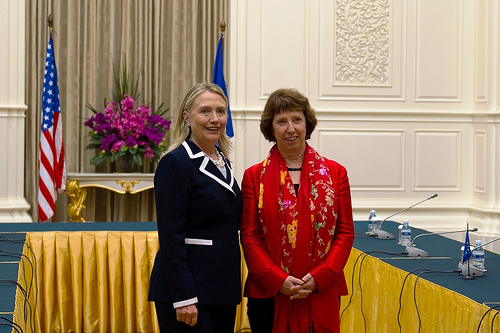
From Patryk Pawlak and Eleni Ekmektsioglou, the Diplomat: The joint statement touches upon several important issues for the region’s stability: North Korea’s denuclearization, democratization in Burma, territorial claims in the South China Sea, and human rights. What stands out from the peace and security section of the statement is the EU’s pledge to support cooperative solutions for resolving territorial disputes in the South China Sea. Given Europe’s vested interests in maritime security and the freedom of navigation, Brussels decision to adopt the United States’ procedural approach –we do not take sides but we want this dispute resolved peacefully– vis-à-vis the South China Sea was a wise choice. The transatlantic partners managed to keep the security part of the statement quite balanced. However, striking the right tone in the trade and economics section appeared to be a more daunting task. Behind phrases such as working together ”to improve reciprocal market access for goods and services including government procurement…and to protect intellectual property rights” one can only read China.
This being said, the joint EU-U.S. statement is an excellent starting point for closer transatlantic cooperation in the Asia-Pacific. It breathes new life into the transatlantic partnership’s efforts to coordinate their Asia policies and reaffirms the EU’s willingness to increase its involvement in the Asia-Pacific region. Far more important and complicated than the pledges laid out in the statement, however, is deciding what actions the two sides can take to move from words to deeds. The EU still faces an assortment of obstacles to formulating a clear, coherent strategy for the region that, in contrast to all Council papers so far, puts some actual meat on the bone. Unlike in the U.S., where the rebalancing to Asia policy has bipartisan support, in the EU the Asia-Pacific region is a divisive issue.
Jonathan Holslag, for instance, argues that European leaders should abstain from taking on a new Asian mission. According to Holslag, it is better for Europe to know its limitations and interests than to make itself look ridiculous posing as a would-be power in Asia. And it looks like some experts from the Asia Pacific would agree with him. Hugh White, one of the most prominent Australian experts, has argued “there is simply too much power in Asia itself for faraway Europe to have any impact.”
On the other hand, Jonas Parello-Plesner, another high-profile European Asia analyst, contends that Europeans should “engage much more in Asian security” and goes on to say that the ”EU’s next mission, beyond the Euro Crisis, is to become a global player.” The results of the survey of more than a hundred European and American experts released recently by the EU Institute for Security Studies in Paris suggest that the level of satisfaction with the EU’s current performance in the Asia Pacific is low and that the EU is expected to assume a more active role in the region. But the question remains: how to achieve this?
It is no mystery by now that the EU’s recent activity in the Asia-Pacific is mostly due to pressure from the United States. When the European External Action Service – the diplomatic service of the EU – received the invitation from the State Department to work towards a common agenda in the region, European officials struggled to find a response. Should the EU go to Asia taking the transatlantic path or perhaps focus on its own objectives first? While internal EU competition for Asian markets makes it difficult to define a joint European vision in the region, the long-standing mistrust between the Europeans and Americans contradicts the rhetoric of “old partners sharing the same values.”
Patryk Pawlak and Eleni Ekmektsioglou work for the EU Institute for Security Studies in Paris. They are currently coordinating a research project, “Look East, Act East: Transatlantic Strategies in the Asia Pacific. (photo: Department of State)
Image: State%208%209%2012%20Clinton%20Ashton.jpg
